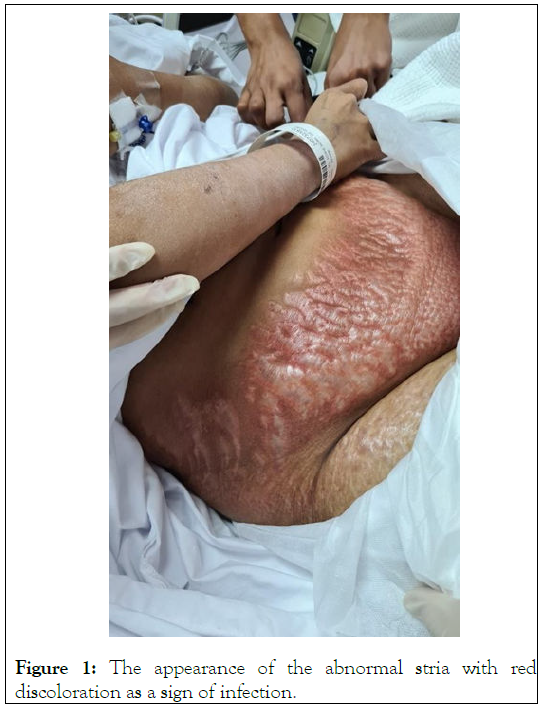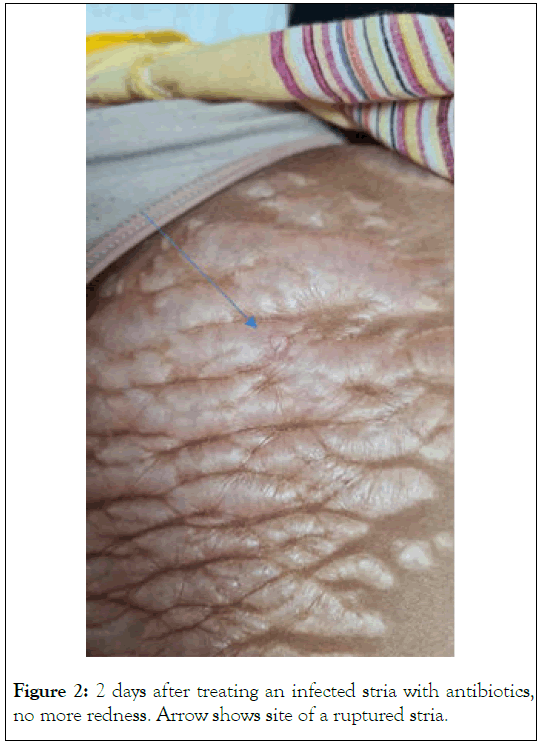Journal of Clinical & Experimental Dermatology Research
Open Access
ISSN: 2155-9554
+44 1478 350008
ISSN: 2155-9554
+44 1478 350008
Case Report - (2021)
Introduction: The use of steroids and the accumulation of fluid within the body have been contributed the worrying presentation of bullous striae distensae which is managed conservatively, and medical interference has not been reported.
Case: 13-year-old presented with generalised edema to the ER with abdominal and upper thigh lesions which are diagnosed as bullous striae distensae and it was very tender and erythematous. The patient clinically improved after treating her with antibiotics.
Result: Bullous striae distensae can be infected and conservative management is not always the appropriate choice.
Conclusion: Consider examining the bullous stria for any perforation or tenderness to prevent and manage suspected infection.
Distended striae; Steroid induced striae; Bullous striae distentia; Infected bullous striae; Angioedema and striae
Skin stria usually has different contributing factors, and the use of steroids can result in the appearance of large striae [1,2]. Bullous striae distensae is a condition which describe the distention of these stria as a result of fluid accumulation [3]. Striae distensae has other complications as it could get ulcerated, edematous, emphysematous and urticated [4], however, the bullous striae have not been commonly reported [3]. Physicians are usually worried about the appearance of this condition which does not need specific management other than reassurance [3]. However, in this special case, the management is different.
A 13-year-old girl was admitted to the hospital for anasarca and diagnosed to have nephrotic syndrome. She was discharged later and enalapril, prednisolone, cyclosporin and hydroxychloroquine were prescribed. Two days after discharge she presented to the ER with worsening edema, difficulty in speaking and breathing with swollen lips and conjunctiva. She was diagnosed with angioedema and intubated. Upon history taking, the mother confirmed that her daughter has been complaining of abdominal pain for two days. On abdominal examination, there was diffused redness and abdominal distention. She also had striae over the lower abdomen and upper thighs. The striae of her abdomen were fluid filled and tense (Figure 1). On palpating the abdomen, it was very tender. Her condition was diagnosed as bullous striae distensae, and as recommended from previous literature, reassurance is the management of choice as this condition clears when the anasarca resolves [1]. However, in this special case, the bullous striae are remarkably tender, and such presentation for bullous striae distensae have not been reported in the literature. Monitoring the signs for sepsis was advised and within few hours her WBC and D-Dimer started to increase. Amoxicillin 1 gram BID was immediately started. Two days after starting the antibiotic the redness and the tenderness of her abdomen disappeared (Figure 2). However, when the patient was closely examined, one of the bullous striae was ruptured and oozing watery fluid. This could have been the main source of infection which led to the abdominal redness and tenderness. Covering the wound with aseptic technique was recommended.

Figure 1: The appearance of the abnormal stria with red discoloration as a sign of infection.

Figure 2: 2 days after treating an infected stria with antibiotics, no more redness. Arrow shows site of a ruptured stria.
Perforation and infection can be a major complication of bullous stria and conservative management is not always the best choice. Also, looking for signs of inflammation and inflammatory markers could be the key to the best approach for such patients.
It has been documented that the striae result from the force of the distention on the abdominal skin [1]. Anasarca that results from nephrotic syndrome along with use of steroids can be precipitating factors for the resultant bullous stria, as steroids are a major cause for the appearance of striae on the body [1]. These striae are different from the normal skin as there is less hydration within the dermis and epidermis along with the reduced elasticity and dermal echo density [5]. The accumulation of fluid within the striae could be due to the its weak tensile strength and the larger the stria, the more likely the accumulation of fluid occurs [1]. The appearance of such distended stria with fluids might worry dermatologists and physicians and rush them to start unnecessary measures, and therefore educating physicians about this phenomenon and the nature of the striae especially when handling patients with fluid overload is essential [1]. Generally, the striae distensae has atrophic epidermis and loss of connective tissue within in the dermis, and it is very difficult to treat it [6]. Lokhande et al. suggest controlling the cause that leads to the edema which could be heart failure, protein losing enteropathy, nephrotic syndrome or hypoalbuminemia [2]. This case enhances the importance of examining the patient for tenderness and a ruptured stria. For instance, history of oozing is suggestive of a ruptured stria. These are important questions and clinical data to detect the risk of infection or an active infection. However, there is still the question of whether to perform ascitic therapeutic tapping for patients with a ruptured stria to prevent infection or reinfection, or to choose conservative management by covering the wound and monitor signs of infection. In addition, this case reports this phenomenon in a patient with captopril induced angioedema, and as it is a commonly given medication to patients with nephrotic syndrome [7], understanding the role of angioedema on distending and rupturing the fragile stria needs furthers studies. Furthermore, regarding preventing such event, apparently depends on the ability to prevent and treat the striae which is clearly not yet available.
Bullous striae distensae is a condition that occurs due to massive fluid distention of large stria and there is a risk of potential rupture and infection that needs careful inspection. For the future, effective ways to treat and prevent the striae distensae are needed in order to prevent such complications.
The authors declare no conflict of interest.
Citation: Almashat SA, Adas A (2021) Infected Edematous Striae Distensae. J Clin Exp Dermatol Res. S11:577.
Received: 13-Aug-2021 Accepted: 27-Aug-2021 Published: 03-Sep-2021 , DOI: 10.35248/2155-9554.21.s11.577
Copyright: © 2021 Almashat SA, et al. This is an open-access article distributed under the terms of the Creative Commons Attribution License, which permits unrestricted use, distribution, and reproduction in any medium, provided the original author and source are credited.